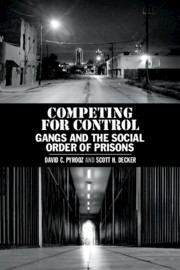Book contents
- Competing for Control
- Competing for Control
- Copyright page
- Contents
- Figures
- Tables
- Acknowledgments
- 1 Foundation for the Study
- 2 Understanding Gangs in Prison
- 3 The LoneStar Project
- 4 The Characteristics of Gang Members in Prison
- 5 The Characteristics of Gangs in Prison
- 6 The Role of Gangs in the Social Order of Prisons
- 7 Misconduct and Victimization in Prison
- 8 Joining and Avoiding Gangs in Prison
- 9 Continuity and Change in Prison Gang Membership
- 10 Implications of Competing for Control
- Appendix Preliminary Evaluation of the Gang Renouncement and Disassociation Program
- References
- Index
10 - Implications of Competing for Control
Published online by Cambridge University Press: 09 August 2019
- Competing for Control
- Competing for Control
- Copyright page
- Contents
- Figures
- Tables
- Acknowledgments
- 1 Foundation for the Study
- 2 Understanding Gangs in Prison
- 3 The LoneStar Project
- 4 The Characteristics of Gang Members in Prison
- 5 The Characteristics of Gangs in Prison
- 6 The Role of Gangs in the Social Order of Prisons
- 7 Misconduct and Victimization in Prison
- 8 Joining and Avoiding Gangs in Prison
- 9 Continuity and Change in Prison Gang Membership
- 10 Implications of Competing for Control
- Appendix Preliminary Evaluation of the Gang Renouncement and Disassociation Program
- References
- Index
Summary
The LoneStar Project was initiated in the fall of 2014 with several ambitious goals. Key among those goals was the successful completion of interviews with gang and non-gang members. By the spring of 2018, the research team had completed two different types of interviews: the first included interviews with 802 inmates in two Texas prisons and the second included two post-release interviews conducted within the first year upon returning to the community. This book is the product of those interviews, official records for each individual, and the subsequent analysis and interpretation of those data. The primary focus of our work has been to produce a comparison of the culture, structures, processes, and behaviors of gang and non-gang members in prison and their roles in controlling prison life. Our approach was mainly quantitative and comparative, although qualitative accounts of these foci are important to this book.
- Type
- Chapter
- Information
- Competing for ControlGangs and the Social Order of Prisons, pp. 251 - 263Publisher: Cambridge University PressPrint publication year: 2019

